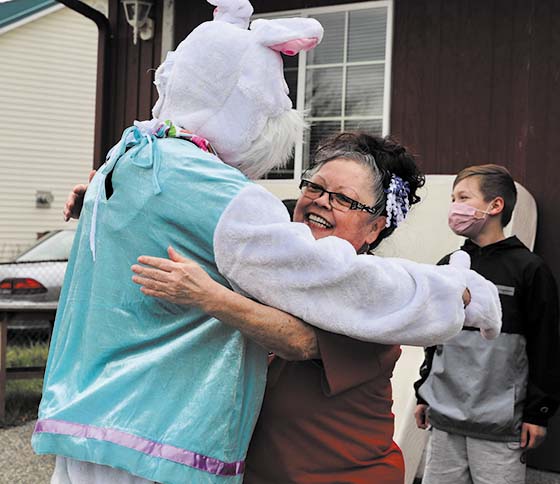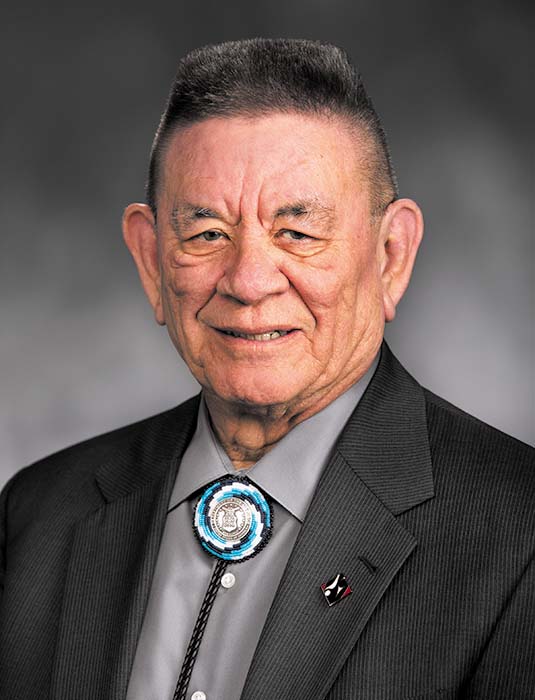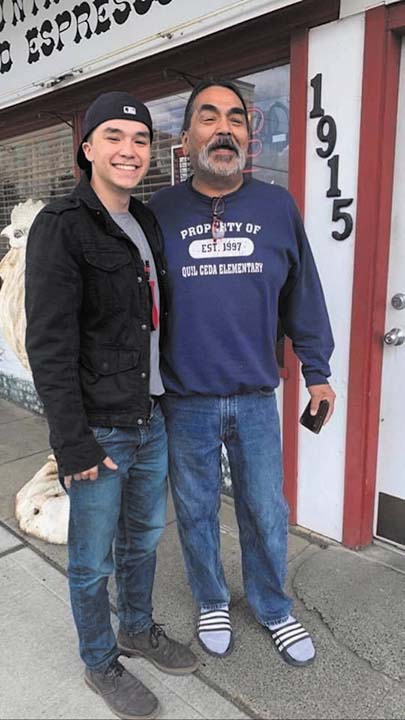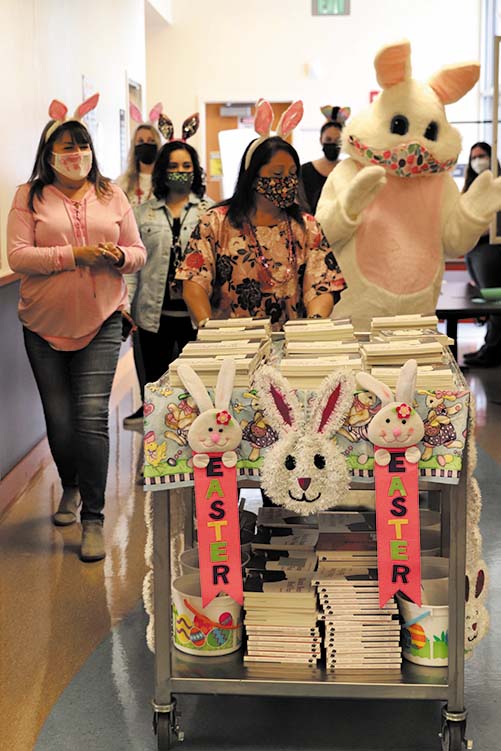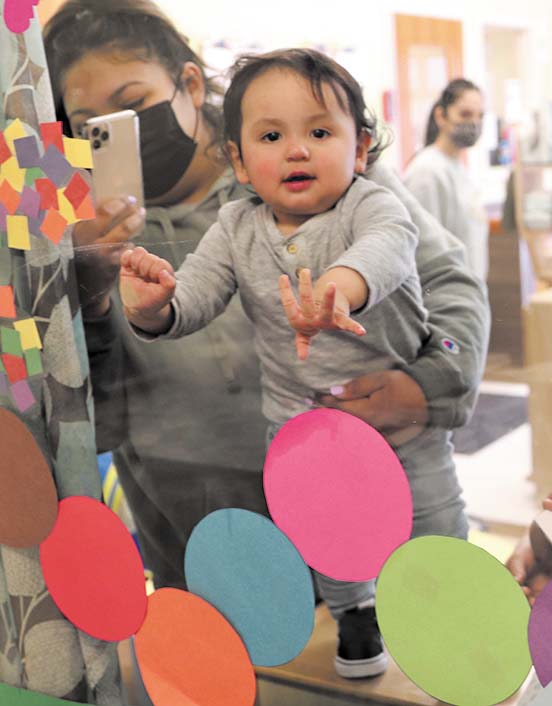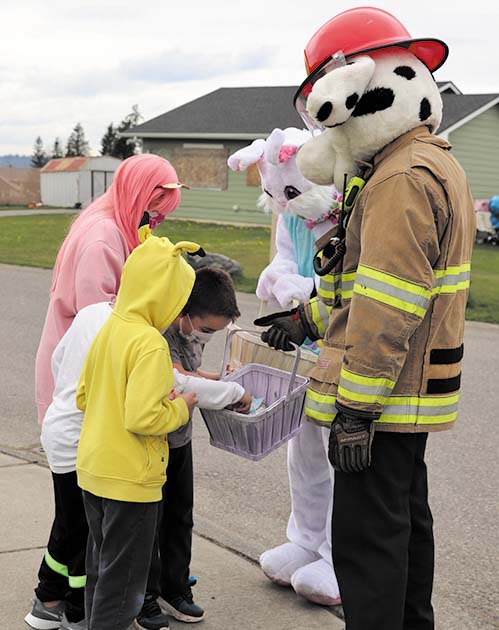
Category: News
Wrestling icon reveals championship insight to youth wrestlers
“Giving up is easy. Making decisions to overcome and choosing actions that will get you to where you want to be is what makes champions.”
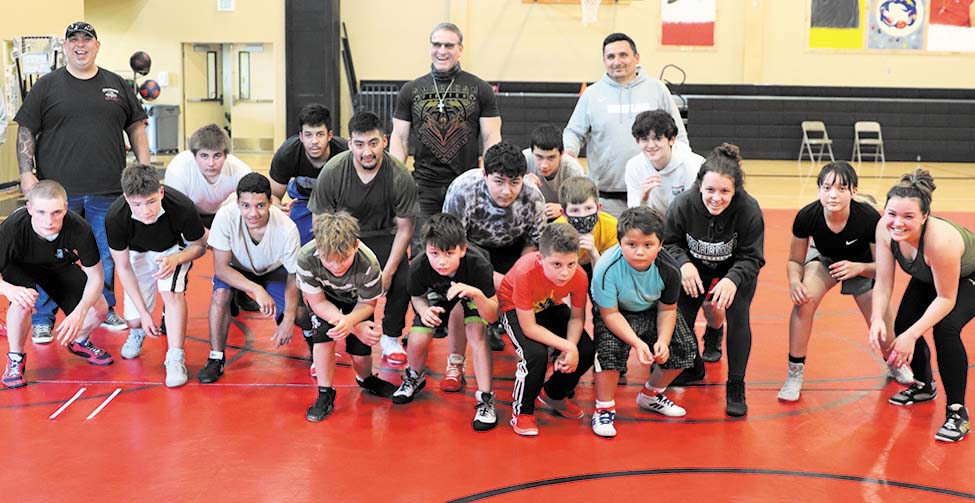
By Micheal Rios, Tulalip News
Seventeen local youth with aspirations to become wrestling champions someday were surprised by a special guest appearance from professional wrestling icon, Ken Shamrock, on Friday, April 23.
“It’s not too often a guy like this walks in the room when you’re in the middle of practice, so it’s exciting to say the least,” expressed coach Tony Hatch. “To be honest, I’m star struck to have a legend of his caliber here with us. Shamrock is one of the pioneers of Ultimate Fighting Champions, he’s a Hall of Famer, and we’re really lucky to have him in the area to share his insight with our kids.”
The former WWF Intercontinental Champion and one-time UFC Superfight Champion shared his experience growing up with a rough childhood and being known as troubled teenager before ultimately turning his life around for the better. The still sweaty from conditioning youth had their attention captivated as the icon detailed how at just thirteen-years-old, his future did not look bright.
Ken had grown up fatherless in a poor neighborhood in Georgia, where he learned life’s lessons on the streets. While his mother worked to put food on the table, he cruised the neighborhood with his friends, causing trouble wherever they could. The first time he ran away from home, he was only ten. He found refuge in an abandoned car with other delinquents, but wound up in the hospital after getting stabbed by another child. In the years that followed, he would be ousted from seven group homes and serve time in Juvenile Hall.
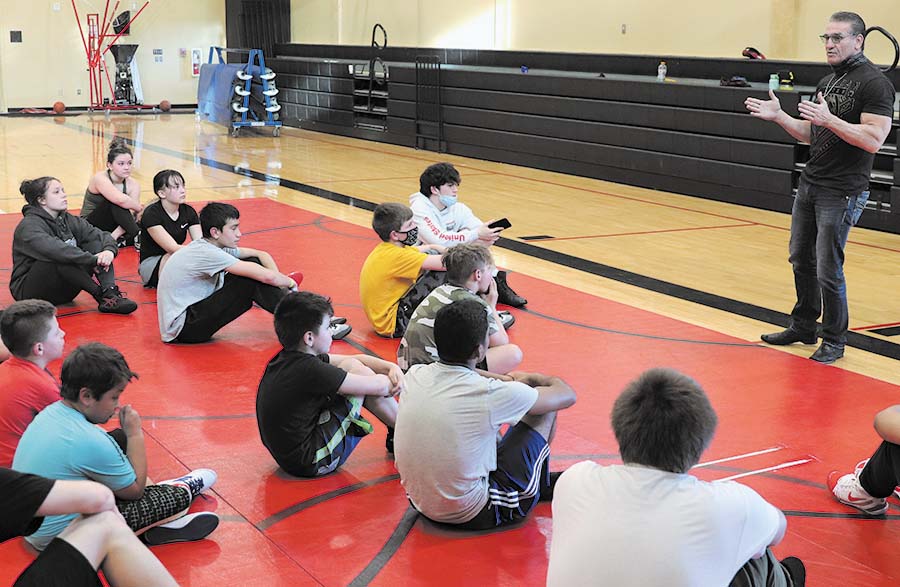
Although the strong-willed youth only weighed 125 pounds, Ken had his own way of looking at the world, and he was always ready to protect his pride with his fists. Showing no signs of rehabilitation, the State grew weary of him. He was given one last chance to turn his life around: he would go to a group home, the Shamrock Ranch, run by Bob Shamrock, a man renowned for working with misguided youths.
Bob had raised more than six hundred boys in his home, and his methods were both unique and effective. In response to the feuds that often arose with prideful boys sleeping under the same roof, he offered them an unorthodox method of resolution. If both parties were willing, he allowed them to throw on boxing gloves and duke it out in the backyard. It did not take long before Ken was the house champion in both boxing and wrestling.
Recognizing the boy had tremendous athletic ability, Bob redirected Ken’s anger into sports. He got him on a weight-lifting program and registered him in wrestling and football. Along with becoming a leader for the other boys in the group home, Ken also became the son Bob Shamrock never had. Shortly after Ken turned eighteen, Bob legally adopted him, which is the origin story to how Shamrock got his now famous moniker.
“Your coaches have shared with me that some of you can relate to aspects of my upbringing,” said Shamrock after detailing his childhood to the attentive teenage wrestlers. “For those who can relate, I stand here as a testament of what’s possible despite growing up under such challenging conditions. For those who can’t relate, I promise each and every one of you are going to go through some kind of adversity in your life, whether it’s in high school or as an adult, that will test you to the core. And in those moments, only you can make a decision to do something about it, to choose a means of action to overcome the challenge, or to give up.
“Giving up is easy. Making decisions to overcome and choosing actions that will get you to where you want to be is what makes champions,” continued the legendary mixed martial artist. “You can start right now, at your age, and make the decision on what it is you want to do and start following a path of hard work and commitment that will get you there. Hard work goes beyond the wrestling mat; it’s at home with how you nourish your body and manage your family relationships, it’s in the classroom with embracing your education, and it’s in your commitment to being your best self even on the hard days.”
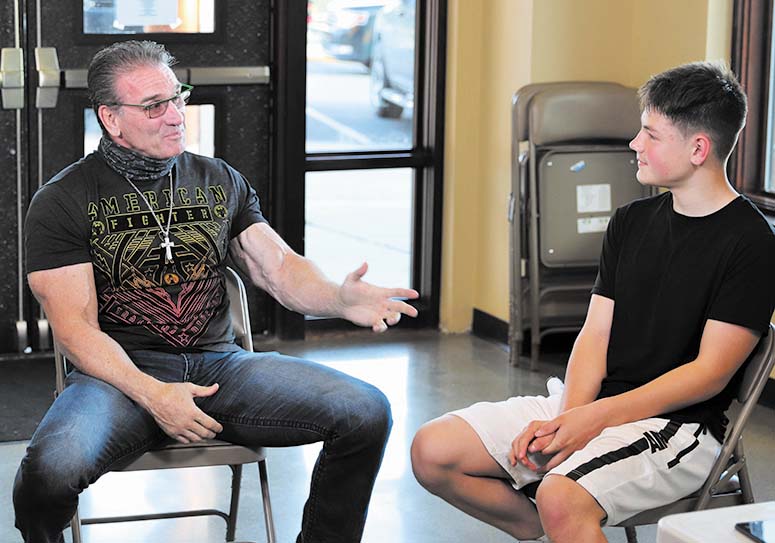
Following his heartfelt words of encouragement, Shamrock sat down with 15-year-old Tulalip wrestler, Milo Jones for a one-on-one session. They discussed chasing dreams, the importance of staying properly hydrated and eating the right foods for maximum physical performance, and weight lifting techniques used by the pros.
Millions of fans worldwide have not forgotten all Shamrock has contributed to the sport of MMA and WWF over the years. Whether it be choking competitors out in the octagon, slamming his opponents in the rings of professional wrestling, or entertaining the masses in mainstream movies and books, Shamrock has always embodied the essence of what it means to be a Hall of Famer. His legendary reputation only grows after taking time out of his busy schedule to inspire the next generation.
Elevate your game with strength and conditioning
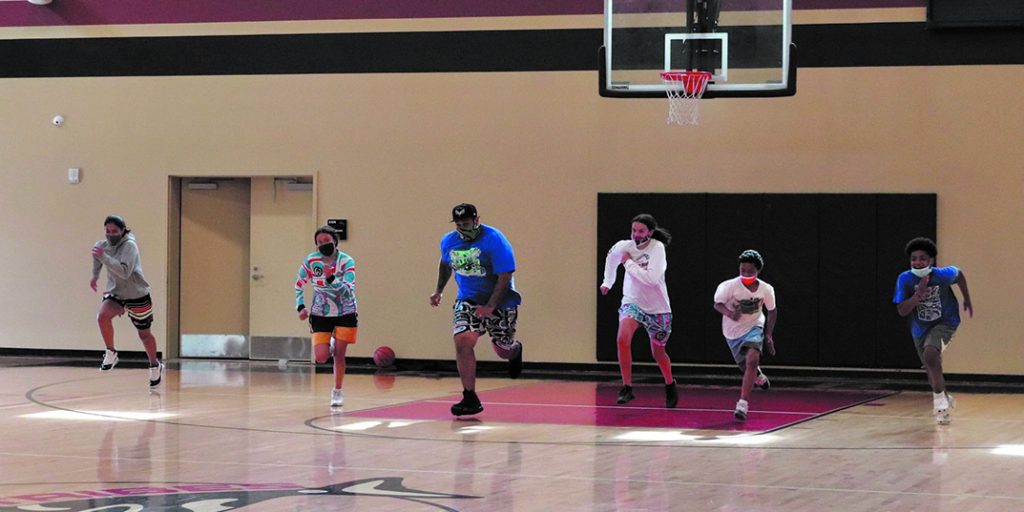
By Kalvin Valdillez, Tulalip News
“I think it’s important to stay fit and healthy,” expressed young Tribal member Kyla Fryberg. “I play a lot of sports and I don’t want to get super tired in games or practices. I’d like to see more people get up, come out and do this with us instead of staying inside because I know quarantine has been a lot on everybody. I think it would be nice to see more kids.”
Glimpses of normalcy can be spotted every now and again in a world post the global COVID-19 pandemic. As restrictions are lifted, vaccines administered and the outside world continues to open back-up, people are re-engaging and re-igniting their love for activities that were either limited or altogether banned to stop the spread of the disease.
Throughout the pandemic, the Tulalip Youth and Family Enrichment program has remained a space for Tulalip youth to experience some of that normalcy by continuing to provide services, host gatherings, and offer all sorts of fun for in a safe, responsible manner. As school districts turned to Zoom to offer teachings and instruction to their kids, the Youth and Family Enrichment department converted their entire campus into a socially-distant learning environment, where students could work online and complete assignments in their own safe-spaces.
Now that schools are back to teaching in-person lessons and many youth sports have fully-resumed, Youth and Family Enrichment are slowly rolling out some of their activities and events that were popular amongst the public, pre-coronavirus, as well as debuting many new ideas.
The Youth and Family Enrichment department recently began a new activity-program called Strength and Conditioning, to help build endurance as well as promote health and fitness to kids who spent the majority of 2020 indoors and more-than-likely in front of a screen.
Youth and Family Enrichment Manager Josh Fryberg explained, “We’re doing basketball conditioning every Tuesday and Thursday from 3:30 p.m. until 5:00 p.m. Right now, it’s open to 6th – 12th grade. Eventually, we want to do family nights to encourage the families to come workout together and be as healthy as we can. Conditioning, overall, is something all of us need and something that all of us should practice on a regular basis, so we can have nice long healthy lives.”
With good early 2000’s hip-hop blasting in the background, a group of five showed up to the Greg Williams Court on April 27, for the tip-off, so-to-speak, of the new Strength and Conditioning program. With a shared goal of fine-tuning their game in anticipation of summertime tournaments, the group was locked and zoned-in throughout the hour-and-a-half class, sprinting the full-length of the court multiple times and hustling their tail-ends off during drills.
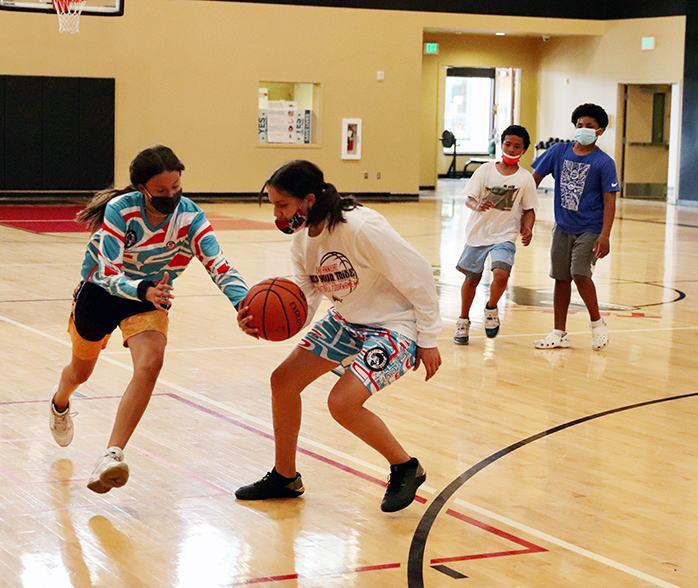
“A lot of things we’re doing right now are fundamentals for lay-ups, left-hand and right-hand dribbling, we’re also working on spin-moves as well as doing a lot of cardio and shooting on our shooting machine,” said Josh. “I usually have them go about three to five minutes in each area. We’ll also stretch, drink a lot of water and work on breathing techniques, in through the nostrils and out through the mouth, so you get the maximum amount of oxygen.”
Basketball is an important aspect in many Native cultures as countless bonds have been made through the sport, by way of both local rez-ball pick-up games and inter-tribal tourneys. Reservation-based high school basketball games are popular community events where friends and families ban together to support their tribal teens as they showcase their on-the-court skills and love for the game.
With only five participants at the first session, Josh led a fun and fast-paced class that had the feeling of a summertime basketball camp, like the ones often hosted by former NBA all-stars and local hardwood legends. It’s easy to envision, in the near-future, the Greg Williams Court jam-packed with youngins working hard to elevate their game.
“Basically, what we did today was strength and conditioning and we were working on running,” said Lillyannah Fryberg. “It was like basketball training, getting us in shape for tourneys and really, it’s just better for our overall health in general.”
Added Kyla and Lillyannah’s sister, Julianna ‘Julie’ Fryberg, “It’s my dad so he goes extra hard on us. He makes us do a lot of exercises that he knows we can handle, just pushing our limits to see how far we can go. It’s really nice to see him help other kids too, other than his own. It would be nice for more people to come though, we had five people today, and we definitely want to see a bigger group. We are working on a bunch of drills; spin-moves, lay-ups, free-throws, three-pointers and running to build our conditioning. So, come on out, it’s fun and I can’t wait to see everybody next time.”
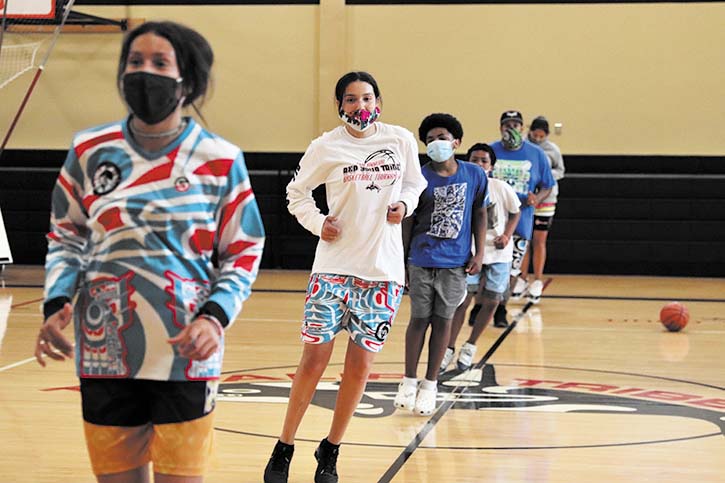
Josh explained that there is a-whole-nother aspect of the basketball skills and stamina building program, aside from improving one’s basketball IQ and skillset, and that is diabetes prevention and the promotion of healthy lifestyles. And thanks to a strong relationship with the Tulalip Diabetes Care and Prevention Program, the Youth and Family Enrichment team received two basketball shooting machines that automatically rebounds your shot and feeds you the rock at different locations on the court.
“A big thing that we face in Indian Country is diabetes,” he stated. “With these shooting machines, that were donated by our Diabetes program from Roni Leahy and Dale Jones, the goal is to get as many shots for diabetes as you can. So, that’s one of the things we’re doing with this program as well, prevention work for us to be as healthy as we can.”
Josh assures that this is just the beginning, stating that the Youth and Family Enrichment program is planning more activities, events and programs extending into the Summer and Fall months. And after helping establish both a little league division and a football program, the department is now in the early-planning process of bringing yet another new sporting league to the community.
Josh shared, “One thing we’re currently working on is starting up a Tulalip AAU [Amateur Athletic Union] program. We want to start with three divisions and work our way up, for all of our players and volunteer coaches to participate in. That way we can really bring our youth in and get them to that next level of competition, so that we can get more of our athletes into college and the recognition that they deserve.”
The Strength and Conditioning course takes place from 3:30 p.m. – 5:00 p.m. every Tuesday and Thursday at the Greg Williams Court. For more information, please contact the Tulalip Youth and Family Enrichment program at (360) 716-4909.
UFC legend Ken Shamrock connects with signature style at Tulalip Remedy
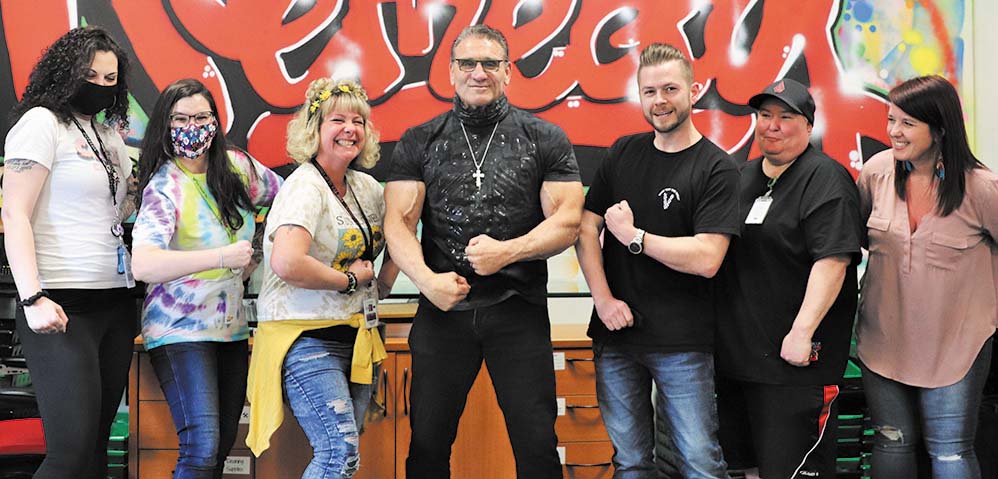
By Micheal Rios, Tulalip News
In collaboration with The Dab Roast and Tulalip entrepreneur Rocky Harrison, Ultimate Fighting Championships (UFC) hall of famer Ken Shamrock made a special guest appearance at the reservation’s retail cannabis establishment on Monday, April 19. His highly anticipated arrival during National Cannabis Awareness Month was well-received by professional wrestling followers, UFC fans, and, of course, cannabis enthusiasts
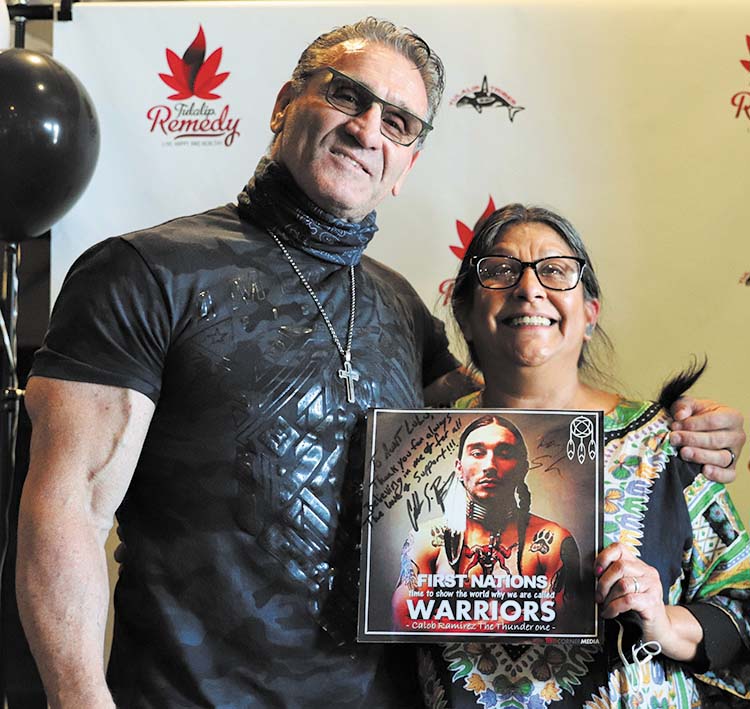
“Shamrock is here today to promote The Dab Roast, a new high quality vendor we recently got in for cannabis concentrates and who tribal member Rocky Harrison hooked us up with,” explained Remedy manager Jenn Bontempo. “This is significant because it marks our first celebrity appearance at our store. Having celebrities promote Remedy and the products we sell broadens our customer base and brings in more potential tax revenue for the Tribe. As a staff, we’re very excited to see what opportunities this creates for us going forward.”
The fittingly nicknamed World’s Most Dangerous Man’s arrival to Tulalip was confirmed only days prior. Yet it built enough buzz for a platoon of adoring fans to descend on Remedy with childhood memories of his WWF wrestling, vintage ankle lock days, or more recent recollections of his dominance as a mixed martial artist during the UFC’s foundational years.

One such super fan was 34-year-old Jason Willden of Arlington. A regular consumer of Remedy’s diverse cartridge selection, he was ecstatic when he got word that Shamrock would be doing a meet and greet. He arrived nearly three-hours early, was first in line, and waited patiently for an autograph on his replica WWF Intercontinental Championship belt.
“Shamrock was my whole childhood!” exclaimed Willden. “I remember being a little kid and watching TV when he became Intercontinental Champion in 1998. His wrestling persona was to always be the aggressor and just kick-ass.”
As anticipation continued to build, the line began to wrap around Remedy. The early Summer-like weather of high 70s and radiating sunshine was perfect for the occasion. When doors opened and the event began, eager fans scurried inside Remedy where they had ample opportunity to purchase cannabis products, like the Dab Roast concentrate or some simple pre-rolled joints to elevate their mood.
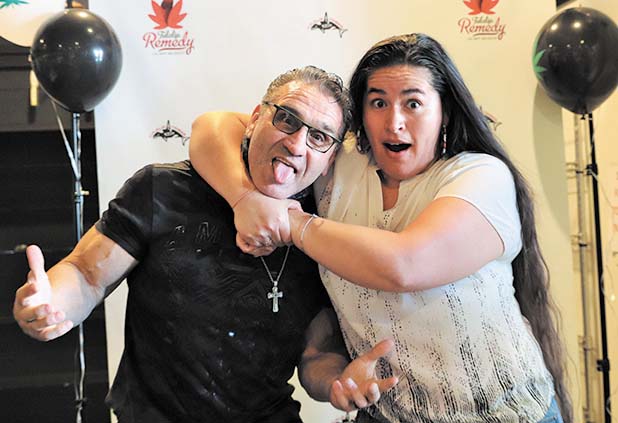
Unable to contain her excitement while waiting in line, proud auntie Emerlinda Sanchez stood out as she spoke to her MMA fighter nephew Calob Ramirez (Chickasaw) via video chat on her cell phone. Calob was unable to attend in person because he’s currently training in New Mexico, but thanks to mobile technology was still able to exchange a heartfelt message with one of his heroes.
“Shamrock is a tremendous wrestler, grappler, striker…put simply, if it weren’t for guys like him, I wouldn’t have the opportunity to do what I’m doing,” said Ramirez. “I’m so grateful to praise a living legend and express my gratitude for his inspiration on me and so many others who have pursued a career in mixed martial arts.”
While many of the Remedy visitors came from off reservation to see the now 57-year-old former UFC Superfight Champion, there were a share of Tulalip citizens who turned out for the occasion as well. Super heavyweight David Enick, known for a thunderous punch in his kickboxing days, admitted he was a little nervous to meet Shamrock, but couldn’t pass up the opportunity shake his hand and get a picture.
“For me, I don’t know Shamrock too well from his UFC days, but have lots of memories watching him perform in WWE,” said David. “It was shocking to meet him and really cool to exchange my experience as a fighter with one of the legends.”
After two excitement filled hours of exchanges with fans, signing autographs, and providing photo opportunities there was one moment that stood out from the rest. One wrestling superfan was absolutely overcome with emotion as the WWF icon signed his authentic 1997 Ken Shamrock action figure he’s owned since childhood. If that ain’t love, we don’t know what is.
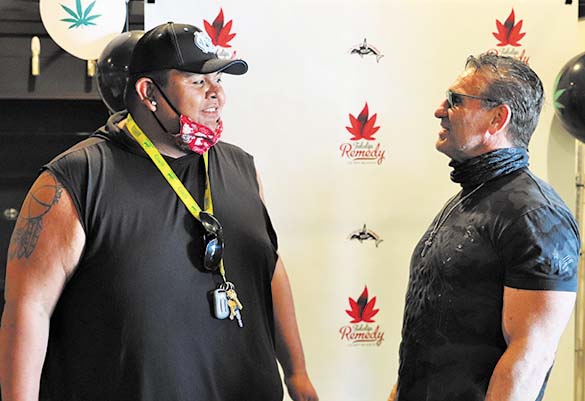
An expression of pure joy radiated from one fan to another, which Shamrock later described as “So cool. Those kinds of fan interactions really show the impact and inspiration that we as professional athletes and entertainers have. The fans are the main ingredient to our success, so being able to talk to them, hear their thoughts, and share in experiences about what I meant to them growing up is awesome. Events like this really allows me to show my appreciation for their support.”
Fans came from near and far to have the WWF and UFC legend sign a beloved piece of memorabilia, say ‘thank you for all the memories’, and have a pic snapped with the World’s Most Dangerous Man. Tulalip Remedy anticipates this being just the beginning. Stay on the lookout for more celebrity appearances in the near future.
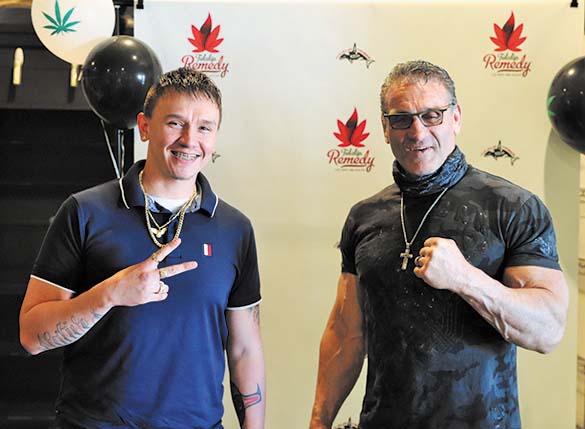
Boom City vax site halted amid Johnson & Johnson setback
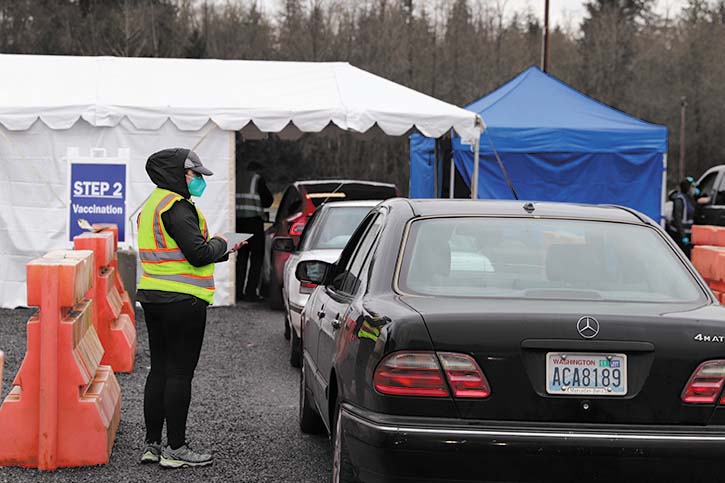
By Kalvin Valdillez, Tulalip News
A partnership between the Tulalip Tribes and the Snohomish County Health District was showcased and executed with the opening of the mass vaccination site at Boom City.
“We were approached by the county, our partners, to see if we’d be able to provide a site for mass vaccination for our whole community. We can’t do this alone. Everyone needs to be involved. Everyone needs to get their vaccine for this pandemic to slow down, so we can really curve that and get back to normal,” expressed Tulalip Emergency Preparedness Manager, Ashlynn Danielson, prior to the site’s opening.
After weeks of planning, the partnership’s shared vision of providing vaccinations to the greater community came to fruition on April 6, when the Health District administered the first round of vax shots to the public. The shots were administered by appointment only and one receiving the vaccine had to meet a number of qualifications to be considered eligible for the COVID defense serum.
The large lot located behind the Tulalip Resort Casino, home to many firework stands during the summertime, is divided into sections by small orange cones, strategically placed throughout the gravel lot to create multiple driving lanes. The site features four checkpoints, designed to keep the patient on-track and the flow of appointments running smooth. During the first week of the site’s opening, patients were in-and-out of the drive-thru style site in under an hour.
On the second day of operations, the Boom City Site Pod Manager, Peyton Plucker, explained the layout of the site. “We’re just kind of bringing people through, getting them where they need to go,” he said. “Through the security to make sure they have an appointment, where we write a number on the windshield – how many people in the car are eligible and have an appointment to get their vaccine. We bring them over to the screening station and we give them their vaccine record cards, so they have proof that they got their vaccine. And they head to the vaccination tent and they get asked a couple more questions there and then get their vaccine. And then lastly, they go to either their 15-minute or 30-minute observation time, and then they exit the property.”
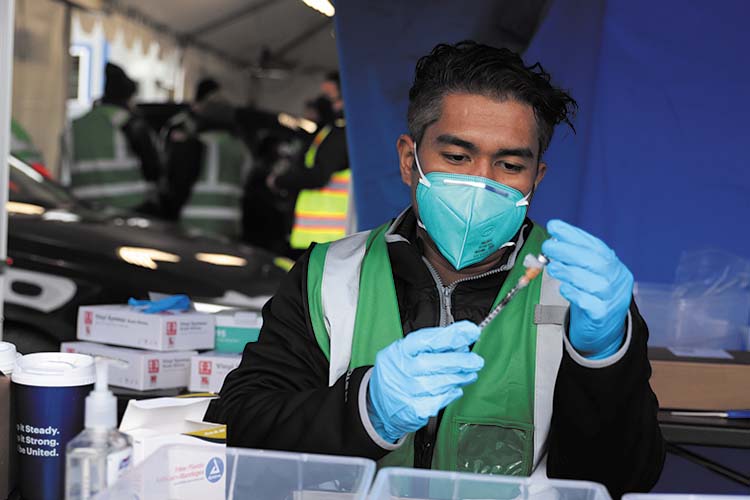
The Boom City location is Snohomish County’s sixth mass vax site and was projected to serve upwards of 2,000 patients a day, depending on vaccine allocation. The planning committee of the site believed the location could easily administer 50,000 doses per week, if and when the vaccine was made readily available.
After receiving her vaccine, Snohomish County citizen, Dynae Ingle, shared her experience at the Boom City site expressing, “It was a really easy process and no wait. It was all on-time and everything went great. At first, I was against getting the vaccine, because of nerves. But I work with the public and I didn’t want to take a chance on infecting other people.”
Unfortunately, due to unforeseen circumstances, the health district is currently not taking appointments at the Boom City site, after only one week of operations. When the FDA and CDC issued a temporary halt on the Johnson & Johnson vaccine due to reported blood clots, that also put a pause on vax distributions at Boom City, as that site was prepared to primarily provide the Johnson & Johnson brand, though they did initially administer Moderna on the first day of appointments.
There are no reported updates about when the on-the-reservation site will re-open, however, other mass vaccination sites are still in operation, where Moderna and Pfzier are offered, including the Boeing Everett Activity Center, Edmonds College as well as drive-thru locations stationed in Arlington and Monroe. To find out more information, such as eligibility, availability and how to schedule an appointment, please visit the Snohomish County Health District website, https://www.snohd.org.
‘True visionary’ John McCoy honored with State Senate resolution
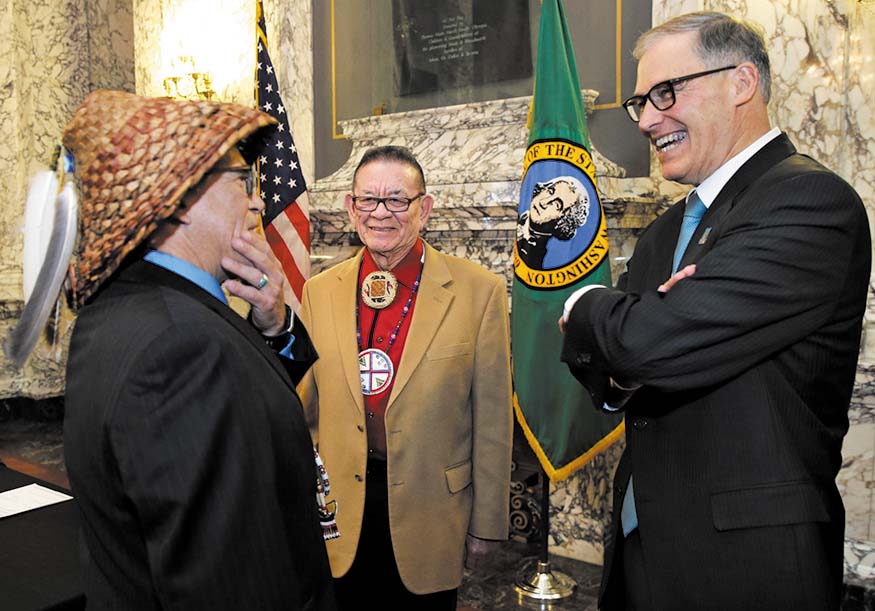
By Micheal Rios, Tulalip News
Highly regarded Tulalip citizen and now retired State Senator John McCoy was honored by Washington’s Senate on Friday, April 9. McCoy retired a year ago, shortly after winning re-election, because of health challenges. His sudden departure during such a turbulent time didn’t allow for his colleagues to give him a proper send-off. That unsettled acknowledgement was remedied during April 9’s legislative session when State Senators, both democrat and republican, passed SR 8623 – Recognizing Senator John McCoy.
“It is my great honor to bring this resolution before the [Senate] today to honor my friend, mentor, and colleague Senator John McCoy,” said Senator June Robinson (D-Everett), who succeeded McCoy in the House and now the Senate. “The words of the resolution talk about many of the wonderful qualities that Senator McCoy brought to the legislator and everything that he does.
“He is the ultimate long-game player,” she continued. “In true Native American philosophy he always reminded me to think about the future and to think about the long game. You can make this decision now, but you can change later. Sage advice from a true visionary. Someone for whom this body and the state of Washington and the people of Washington are much better off because of his service.”
After 17 years of service in the Washington State Legislature, McCoy announced his retirement after submitting a resignation letter to Governor Jay Inslee last April. The longtime Democratic lawmaker leaves behind a legacy of steady leadership and commitment to serving his community. He brought a career in military service and years as a computer technician to his work at the Legislature, culminating in a lawmaker who effectively advanced economic development and equality of opportunity for his district.
“John has been a good friend for many years. If you live in the Snohomish County area, then you’ve seen John at democratic events and all the community events. He is a rock within the community,” described Senator Steve Hobbs (D-Lake Stevens). “Everyone talks about how he is a rock within the tribal community, which is true, but he’s also a rock in the greater community of Snohomish County as well. He has been such a leader on issues regarding tribes, water and the environment. John is also a huge advocate for our veterans. On that note, as a fun fact, John has had that high and tight since the ‘60s.”
During his five terms in the Washington State House of Representatives, McCoy fought for students, for the environment, for a healthy economy and for tribal communities. He sponsored policy that expanded support for students struggling with behavioral and emotional health needs, protected water rights and access, and integrated comprehensive tribal history and culture education into teacher preparation programs.
“Rising in strong support of this resolution honoring Senator McCoy,” said Senator Ann Rivers (R- La Center). “My politician DNA is very different than John’s, but that doesn’t mean that there’s a lack of respect there. While we may not fully agree on all things or have different approaches on where we want to be, there are some things we agreed on wholeheartedly, like his tireless efforts on behalf of children and making sure their cultural needs are met so they can adequately learn in schools. It was a real honor to be on the same side of policy with him.”
McCoy’s most notable political achievement may be Senate Bill 5433, which he authored and was subsequently signed into law in May 2015. Senate Bill 5433 made it mandatory for schools to educate students about the history and governance of northwest coastal tribes. Washington has since worked diligently with sovereign tribal nations to develop a first-of-its-kind curriculum, Since Time Immemorial: Tribal Sovereignty, which is taught in schools throughout the state.
“John is a quiet giant both on local and national affairs,” explained Senator Steve Conway (D-Tacoma). “Acknowledging the role he played in bringing tribal issues to this legislature and creating a committee focused on Native Americans in this state. A leader in the Native American community, he’s made an imprint on Washington State history and American history by bringing focus to Native American issues in our state and country.”
The 77-year-old retiree’s focus now shifts to spending time with his wife Jeannie, their three daughters, ten grandchildren, and two great-grandchildren His considerable contribution and service to public office is characterized by tireless advocacy for Native American communities, expanded access to high-quality education, and environmental sustainability.
Before McCoy became one of the longest serving Native American legislators in state history, he led efforts to bring better telecommunication infrastructure to the Tulalip Tribes. He was also instrumental in developing the economic powerhouse that is Quil Ceda Village. Quite the legacy.
______________________________________________________________________
SENATE RESOLUTION 8623
By Senators Robinson, Billig, Brown, Braun, Carlyle, Cleveland, Conway, Darneille, Das, Dhingra, Fortunato, Frockt, Gildon, Hawkins, Hasegawa, Hobbs, Holy, Hunt, Keiser, King, Kuderer, Liias, Lovelett, Mullet, Nguyen, Nobles, Padden, Pedersen, Randall, Rivers, Rolfes, Saldaña, Sheldon, Short, Stanford, Wagoner, Warnick, Wellman, Wilson, C., and Wilson, L.
- WHEREAS, John McCoy was first elected to the Washington State House of Representatives in 2003 and was elected to the State Senate 2in 2013;and
- WHEREAS, John McCoy was a dedicated public servant, faithfully 4and tirelessly representing the people of the 38th legislative 5district for 17 years before retiring in 2020; and
- WHEREAS, John McCoy began his honorable service with a 20-year career in the Air Force, gaining experience that would inform his deep dedication to serving the good of the people; and
- WHEREAS, John McCoy was a leader in the community through his work to diversify the economy of the Tulalip Tribes by establishing and managing Quil Ceda Village; and, was a leader in the Senate as Chair of the Senate Democratic Caucus, never wavering in his inclusive and supportive approach to leadership; and
- WHEREAS, John McCoy worked on a wide breadth of issues, including advocating for disenfranchised communities, lifting the voices of sovereign tribes, and expanding access to quality education and health care, as well as internet access for every Washingtonian; and
- WHEREAS, John McCoy was an unrelenting force for those with the least financial resources and political power in the state, giving a voice to those who did not have one in our political process; and
- WHEREAS John McCoy championed the passage of the Native American Voting Rights Act that expanded voting rights access in tribal communities; and
- WHEREAS, John McCoy passed legislation that ensured Native American history, culture, and government would be taught in all school districts; and
- WHEREAS, John McCoy worked persistently for 12 years to pass legislation that would allow dental therapists to provide care on reservations; and
- WHEREAS, John McCoy was a strong advocate for the environment, pushing for tougher rules on oil transportation and water quality, as well as expanding production of alternative energy; and
- WHEREAS, John McCoy faced challenges that seemed insurmountable with tenacity and perseverance, offering the advice of “It’s okay to make a mistake as long as you learn from it… and are sure not to make the same mistake again!”; and
- WHEREAS, John McCoy will be missed for his steady leadership, strong moral compass, and his ability to find the perfect bolo tie for every occasion; and
- WHEREAS, John McCoy is a loving husband to his wife Jeannie, a father to three daughters, and a grandfather of 10 grandchildren and two great grandchildren
- NOW, THEREFORE, BE IT RESOLVED, That the Washington State Senate recognize Senator John McCoy and the contributions he made to the state and the people during his 17 years of service in the legislature.
I, Brad Hendrickson, Secretary of the Senate, do hereby certify that this is a true and correct copy of Senate Resolution 8623, adopted by the Senate April 9, 2021
BRAD HENDRICKSON
Secretary of the Senate
The Dom Joseph Podcast: A Voice for Tulalip

By Kalvin Valdillez; photos courtesy of Dom Joseph
The gift of gab is a skill, a highly coveted technique that has been perfected over time by the Indigenous Nations of America, who have historically shared the knowledge of their people, by means of oral tradition, to each passing generation. Years upon years, tribes have utilized the art of storytelling to convey important life lessons such as minding your elders, taking care of Mother Earth, and hunting, fishing and foraging for nuts, berries and medicinal plants. Not to mention intertribal ceremonies like namegivings, powwows, potlatches, canoe journey, as well as many other lifetime achievements and celebrations. Stories are an integral piece to the Coast Salish culture, which each new generation continues to builds upon, keeping the traditions and lifeways of the people strong and alive for years to come.
During a modern era where information and technology seem more disposable than ever, Native communities are finding new methods to highlight their way of life and are exploring new ideas to document their stories, that otherwise would have been handed down vocally to a select few. The presence and access to a tool such as the internet, allows the word of the tribe to reach the masses. Anyone inquiring about the culture of a specific tribe are essentially just a few clicks away from learning about that Nation’s true history – of the treaties, the relocation, boarding schools, traditional diets, and in some cases even the ancestral languages and songs are accessible to those who are looking. And what makes it even more exciting is that information is often put out directly from the source today, and isn’t heavily relied upon one-sided history textbooks and ill-informed school districts as it once was.
Tulalip tribal member Dominick (Dom) Joseph’s passion for this traditional skill has led him to the forefront of a new movement that is taking the internet, and therefore the world, by storm. The media format of podcasting has been gaining momentum since the late aughts and has blossomed over the past decade. More and more people are catering to their niche fanbases by creating their very-own platforms to discuss topics that are nearest and dearest to their hearts, whether that stems from a love of music, movies, current world events, self-help, or even exhilarating true crime stories.
Dom has a strong love for his people, his culture and rez comedy which he effortlessly showcases on-air. His unique journey with storytelling and podcasting perfectly displays his adoration and pride for his tribe, his family and his cultural lifeways. When he speaks, he uses his good-natured humor to open up about issues that he is working through, as a young Native college student experiencing life off the reservation for the very first time. The aptly self-titled project, officially known as the Dom Joseph Podcast, provides a space where other Natives can relate, gain perspective, and join-in on a good old-fashion laugh-your-ass-off session with a natural emcee who shares his unfiltered thoughts, jokes and stories on a weekly-basis. His podcast continues to gain momentum as each day passes, and more youth, elders and everyone in between are tuning-in to find out what the Dom Joseph Podcast, often referred to as the DJP, is all about.
Tulalip News: Why don’t we just dive right in? Let’s talk about your background and who your family is.
I’m Dom Joseph; I’m Tulalip. I have one little brother, Lukas Williams. My mom is Chena Joseph and my grandpa is Kenneth Joseph.
What led you to podcasting?
My background really came from editing. I went to Marysville-Getchell and I went to Tulalip Heritage. I started editing at a young age, making funny videos. I started getting into podcasting about three-and-a-half years ago. It all kind of started when me and my grandpa would meet every week and we would talk about football. He’d call and say, “alright grandson, who do you think is going to win?” and we’d sit on the phone for about 20 minutes every week. I thought why don’t I turn this into a podcast, so I can be prepared to talk my grandpa every week. And so, I started my first podcast, which was called ‘Weekly Take’, about three years ago, and that was all sports related. I ran that for about a year and I started really falling in love with the whole process of podcasting. I liked having something to be creative about every week.
It wasn’t until one of my family members was like, “I love your podcast, but I don’t really listen to sports.” I thought, Oh yeah, I guess some people don’t really listen to sports. So, I decided to start another one.

Who are some of your inspirations in the podcasting world today?
Joe Rogan. Theo Vaughn. A lot of the comedians in L.A. who have their own podcast, I think are hilarious. I’ve gotten to actually do some work for Joe Rogan and Theo Vaughn in an internship in L.A. I’ve been doing that remotely because of COVID.
When you were first starting out, did you have an idea of what the Dom Joseph Podcast would be, or a direction in which you wanted to take it?
You know it’s funny, I sat there for about two days thinking about a name. I was like, ‘man, I can’t think of a good name or a logo.’ Eventually I just said, why don’t I make it my name, something easy and then the logo will be my favorite color, which is red, and we’ll just go from there. And ever since then, it’s just been the Dom Joseph Podcast.
You have a pretty awesome backdrop in your videos, is that a Pendleton blanket?
Okay, so the first episode, I didn’t even have video. And then the next episode, it was just my face. And then finally I was like, why don’t I put a Pendleton behind me? But I had the fisherman Pendleton, and that’s the Puyallup designed one. But I’m not Puyallup, I’m Tulalip. I get how that could be a little confusing, so then I had a Tulalip flag up for one episode. When I came back home, my mom was like, “hey, that’s mine.” So, I didn’t get to take that one back home to Pullman, where I go to school and I record at. Eventually I was like, why don’t I just get a blanket that I know everyone has? The latest one behind me, I think I got at a powwow, it’s like the ones sold at Billy’s Blankets in Tulalip.
And so, I went with that blanket because more people have that one, and I thought it was kind of cute. If a little kid wanted to make their version of the Dom Joseph Podcast, I know they have that blanket at home and they could just put that behind them and make something fun. And I also just thought it was funny, it looks like I’m getting a photo taken for a tribal ID.
Were there certain stories that you initially wanted to talk about?
Growing up I’d hear crazy stories about my cousins all the time. Through word of mouth or at basketball tournaments and canoe journeys, just laughs and crazy experiences my cousins lived through. I thought, why don’t I do something like that for my little cousins to have? Maybe if – say I’m out doing something away from home or I pass away, they at least have that piece of me, of my memories to listen to. I think that’s really important, especially as Native people, to have a story we can to listen to and relate to.
So, what you’re doing is, in a sense, traditional. It’s storytelling! That’s how we shared and passed on knowledge through the generations. And now you’re doing that for the future generations through podcasting.
Yeah! You know, the storytelling aspect didn’t really hit me until the middle of the podcasts. I was like, ‘Man, this is actually storytelling.’ I’m out here telling jokes and discussing what I’m going through. And that’s how people learn right? Through the experiences of other people.
Not a lot of us go to school. I mean, the statistic of Native Americans who go to school isn’t really that big compared to much other [ethnicities]. If I could story-tell and just kind of make it sound fun, or make the college lifestyle sound great, that’s important messaging for me, for us. That’s a big part of it, especially for other tribal members. The whole podcast is me – I’m Tulalip and grew up on the rez, so it’s going to sound Native. A lot of people think that I’m pigeonholing myself down to just be the Native guy. Dude, that’s who I am. That’s not a problem for me. Storytelling is a big aspect of my podcast and it’s something that I’m proud to do.
What are some topics that you’ve discussed so far, that you really enjoyed talking about? And what do you wish to talk more about in the future?
Basically, the topics just kind of come up. It’s about what people are going through. For instance, I just had Jared Parks on and he shared about his kettle corn experience, about my little cousin and autism awareness. My favorite thing is to share everyone’s experiences.
Other topics I’d like to talk about are whatever makes people laugh. I haven’t really touched upon the culture or tradition as much as I would like to, so eventually, I’d like to delve more into that. One of the next guests I want to have on is my grandpa. But with elders, I want to make sure it’s a comfortable conversation. I don’t want it to sound forced, I want us both to be comfortable. I really want to have him on just to talk and hear about what it was like at Tulalip back then. Like the stories I used to hear when he’d tell me, ‘grandson, that Admin building wasn’t even there before’ or ‘Boom City used to be on the water.’ Some in-depth stories like that would be really cool to touch upon.
You are essentially bridging the gap between generations, that’s super important in today’s fast-paced society. What are some other reasons you believe hosting a weekly podcast is important?
I think it’s important just for myself, it keeps me busy. I keep myself busy in other ways too, through sports or Xbox or hanging out with friends. But having a creative outlet is really good too. A lot of people have different creative outlets such as making drums or going to sing, I feel like this is a really good outlet for me because I was used to it – I was used to being on my computer and editing around all the time. So, if I was doing it for all these other people and providing value for them, why couldn’t I do it for myself?
For kids just starting out, who want to explore podcasting and use it as a creative outlet, can you talk about some of the equipment that is needed to get started?
I’m actually in the process of making a total course on how to do it, and I’m not going to charge for it, I’m just going to post it. But what kids should do first is just record themselves on their phone. That’s where you can really start, that’s what I started with. But if you want to get into it more, you’ll need a mic, you’ll need a computer, and something that connects your mic to the computer. You can record it on software such as Audacity, or GarageBand if you have a MacBook. There’s a lot of recording software you can use but really all you need is a mic, a computer and the internet.
And this is where I get a lot of questions. I upload it to Soundcloud and when you go to Soundcloud and you upgrade to Soundcloud Pro, you can get an RSS feed. And when you get that RSS feed, that’s how you can feed it to other platforms such as Apple Podcast or Spotify. But having an RSS feed is pretty key if you want to post it to other platforms.

Yeah, I actually heard the DJP on Spotify before I saw any footage.
Spotify is probably my favorite platform that it gets posted to. That and YouTube, because YouTube is video. But yeah, Spotify is definitely my favorite platform because I could see a lot of the analytics easier.
You mentioned your episode with former Tulalip BOD Jared Parks, have you had other Tribal members featured on the pod?
Yeah, I’ve had Darion Joseph on. I’ve had Breland Joseph on. I’ve had my brother on. I’ve had my girlfriend, she’s from Tuscarora. I’ve had my buddies from Yakima on. So yeah, I’ve actually had quite a few Native Americans on the podcast. And I kind of want to keep that key. I’ve also had almost every race of people on there, and I think that’s what makes it open. I want anyone on who wants to come and share.
One of my guests, I met at a sweat. It was my girlfriend’s uncle’s brother, and he was telling me he is comedian. And I was like, let’s record this conversation and it just started from there. You know, we meet people every week and we don’t know whether that person is going to be in our life for that moment, another week or another year. I think if I’m able to capture that conversation for other people to hear, and get insight or experience from, I think that’s really important.
You have a rising listenership forming locally at Tulalip. People on Instagram and Facebook share your podcasts to their stories and timelines regularly. Where do you see the DJP taking you and how do you plan to continue to grow your audience?
My five-year goal is to stay consistent and see where it takes me from there. I see a lot of these successful podcasters right now, in Native America and also the L.A. comedy scene. I keep referring to them because that’s where I’ve been working, just seeing how they’re getting sponsors, or how they book really cool guests. That’s the most important thing, I want to have a platform where I can communicate with cool people, some of my biggest inspirations. And maybe eventually get on their podcast and have conversation. I want to be a voice for Tulalip, that’s a big key for me.
Do you have a certain ritual or anything that you must do before you record the podcast?
Kind of. Every week is different. I wish I had a quirky thing or ritual I did beforehand like eat a lemon or something. But sometimes just getting in front of the mic is the ritual, just to get into that mode as soon as the camera’s on.
What days are the episodes typically released?
I like to release them on Sundays or Mondays. That’s usually the time people don’t really have class. I like to have them recorded by Wednesday or Thursday, and that’s usually the solo episodes. People enjoy the solo episodes because it’s just me, but a lot of people like to also hear from guests. I like to think I’m kind of interesting, but sometimes if you’re listening to me for four episodes in a row, I get how it could be refreshing to hear from others. Like, who’s Dom talking to this week?
For our readers who have yet to check out the DJP, do have any episode recommendations to start with?
Oh, my goodness. That is a very good question. Yes, actually. If I were to recommend any, my little brother’s episode is a really good one, which is titled Lukas Williams 2, Dom Joseph Podcast episode 51. We made this big bracket of animals and we put them against each other, like a March Madness bracket. And the bracket wasn’t necessarily the interesting thing, it was more of the chemistry me and my brother have. And I’ve had some episodes where I have people on and I don’t really mix well with them and that’s okay too.
Another good one was Powwow Judge, episode 65. They get better as they go. And then I believe Powwow Menus is also a good one, which is Episode 77. And then Movie Pondering, which is 76. They’re all pretty good but those ones come to mind.
Right on. I have a feeling a lot of our followers are going to go through and binge a few episodes now.
If people start from the middle, that’s okay. It’s not like a series. I made it so you don’t have to listen to every one sequentially, in order.
Do you see the Native market for podcasting growing in time as well? Do you see other tribal members expressing themselves through the art of podcasts in the near future?
Oh yes, of course. I actually think I heard this in high school, but we were the first people ever to get our pictures taken. The first camera was used by some guy who went to a reservation and took pictures of Native Americans. I think this podcasting platform, for all Natives, is a really big thing that’s going on. I think it’s only going to get bigger. I think eventually, it’s going to get to a point where some individual is going to create a platform that is strictly for Native podcasting. Personally, I think we’re the greatest type of people to do it and I think we deserve to get our voices out there. I believe a lot of Native Americans, especially Tulalips, could story-tell for days and they can make you laugh through it, they can make you cry through it. I definitely do see a lot of Native Americans in podcasting.
It is definitely exciting and filled with possibilities. What fuels your passion for this new form of media?
Mainly, I’m happy with where it is right now with just for my family to hear. As long as I never lose that fun part of it, I’m going to keep doing it. And I think anyone who likes to story-tell should definitely get into podcasting, because it’s a really fun thing to do and everybody has something they could share.
Right now, I don’t have the degrees, the reputations, the following that I would like to be at, but that comes through consistency and contributing my time. That’s what’s going to get me to the end goal, which is to have our people here.
There’s a lot of focus going into mental health today. And of course, as Natives, we deal with generational trauma and work on trying to break those cycles. Do you think that podcasting could help us work through some of that, by talking things out and gaining perspective from others?
When I first started DJP, it kind of started from a place of – I needed to talk to someone. And to be honest it was a hard breakup, that’s what it was. I didn’t know who to talk to. So, I started reaching out. It was a little bit more comfortable for me to talk into a mic than to go meet a total stranger from somewhere I wasn’t from, because I wasn’t home at the time. If I were to recommend anything, I would recommend doing a podcast because it does definitely help with that. But seeing a professional also helped me.
I think podcasting does help with mental health though. It’s something that I can go and talk to for forty-five minutes. Some people talk to their journals and they write for thirty minutes. Me, I kind of go in and vent. And sometimes there are recordings that I don’t even post because it’s really impactful. Or maybe it’s too deep to post, or I say someone’s name and they don’t want me to post it.
Mental health is something I really support. I think in the past ten years, it’s definitely gotten a lot more awareness. And I think with podcasting, it could help bring even more awareness to that, especially for Native kids. Native youth in general, is who I do this for. If someone younger than me from the rez listens, and they are able to get away from that bad thought, that bad experience, by hearing me say something or just telling a funny story they’re able to laugh and just get away from that bad cloud or that bad test grade, that’s what it’s all for.
Alright, last question. Is the podcast suitable for all ages?
Um – sometimes I swear on there. I know that is a big thing, so that’s why I’m hesitant to say it’s totally kid-friendly. Because sometimes I do bring up some 18+ stuff, which is to say I swear like a fisherman on there, and I’m working on that. So, I would say definitely more PG-13.
The Dom Joseph Podcast is available to stream on Apple Podcast, Spotify and YouTube. Next time you need a good laugh, have a long commute, or simply need something to listen to while you run errands, workout or clean the house, be sure to check out an episode of the DJP!
Hare-Delivery: TELA students receive books from Easter Bunny
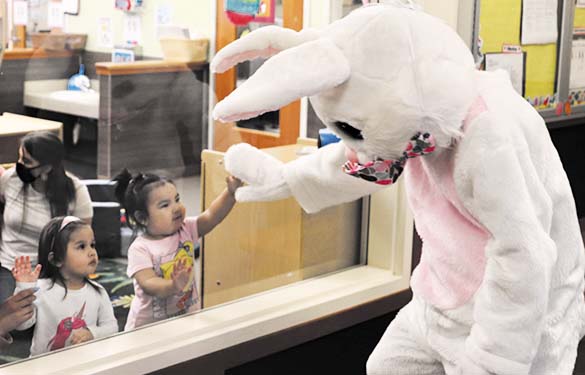
By Kalvin Valdillez, Tulalip News
The Betty J. Taylor Early Learning Academy (TELA) has a long-standing relationship with one Peter Cottontail, famously known as the Easter Bunny. For the past six years, the bunny has journeyed to the sduhubš territory to celebrate his favorite holiday with the Academy’s students. For a while, the bunny hosted the Easter Egg-travaganza which featured an egg-hunt and a photoshoot with the kiddos. Recently, beginning over the past couple years, the Easter Bunny and TELA began a new holiday tradition together by gifting the future generations of Tulalip a Native American-themed storybook they can enjoy with their families while learning the lifelong skill of reading.
“Literacy is important because we want our children to start reading,” said Katrina Lane, TELA Family and Community Engagement Coordinator. “They aren’t able to read on their own right now but if we read to them, they will learn to read even sooner. We also add-in the Native element, so they’re able to see a piece of our culture in reading.”
Talk about a fun way to get children between the ages of birth to five excited about reading! On the morning of April 1, the last school day before Easter weekend, the bunny began to make his rounds, hopping through the Academy’s hallways and visiting over twenty classrooms.
The kids could not contain their joy upon seeing the bunny, shouting, ‘Hi Easter Bunny!’ and the, ‘Easter Bunny is here!’ while jumping up and down and rushing to their classroom windows to interact with the famous holiday character. The bunny, who was masked-up, showcased the importance of social distancing by taking health and safety precautions to limit the spread of the coronavirus, which prevented his annual trip to Tulalip last year when the school and Tribal government temporarily shut-down operations.
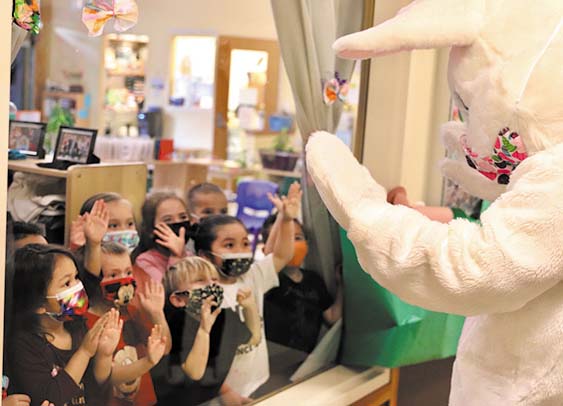
Moments prior to the book-delivery, Katrina shared, “Because of COVID we are masked-up and practicing social distancing and so is our bunny. This year he is able to bring them a book and remind them it’s important to wear a mask and to social distance during COVID.”
The children were delighted to receive their gift from the bunny. Some kids immediately began to flip through the pages and others held the book up-high over their heads, thanking the bunny for their new story, which is filled with fun traditional illustrations. This year, the kids took home Black Bear, Red Fox: Colours in Cree by Julie Flett (Cree- Métis) while the infants of the Academy received Black and White: Visual Stimulation Images for Babies by Morgan Asayuf (Tsimshian). TELA purchased the books at the Salal Marketplace giftshop at the Tulalip Resort Casino through a grant awarded to the Academy by the Tulalip Charitable Fund.
After another successful Easter-themed book-gifting event, TELA is excited to get the literary holiday tradition back on the bunny trail, promoting the magic of reading and hoping to engage their children in the activity both at home and in the classroom to set them up for a bright future.
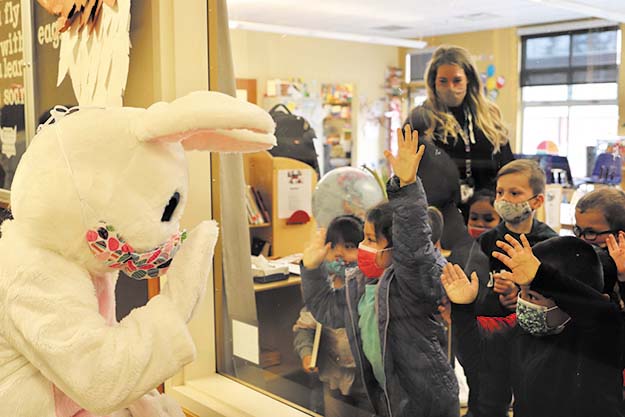
Said Katrina, “Most Easter Bunnies deliver candy, our Early Learning Easter Bunny delivers cultural reading books to promote literacy because we feel it’s important to share the love of a good book!”
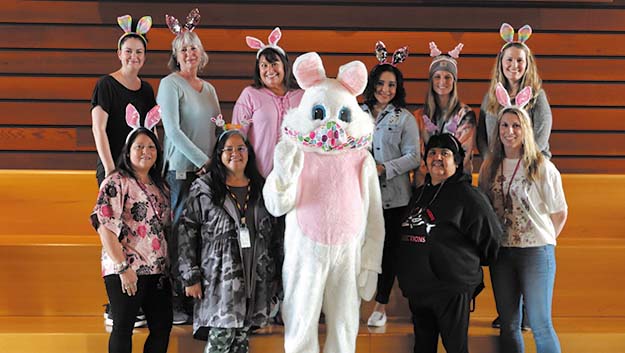
Tribal Council swears-in new leadership after historic voter turnout
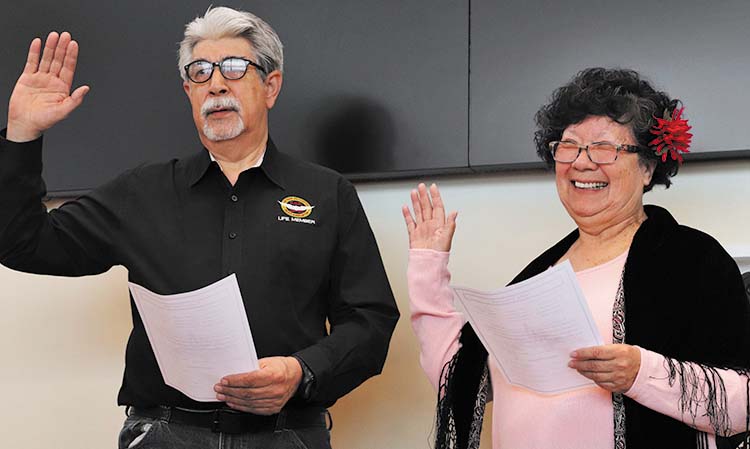
By Micheal Rios, Tulalip News
Back in March 2020, pandemic precautions prevented Tulalip from holding its annual General Council. The Board of Directors election was held though, albeit two months later in May, amongst reservation-wide stay home orders and a lot of self-quarantining. The unique set of circumstances gave many progressive minded citizens plenty to think about in terms of the Tribe’s future direction and immediate needs of the people. As a result, the convenience of being able to cast an absentee ballot from the safety of home led to an unprecedented rate of voter engagement and ballots cast for the 2020 Board of Directors election.
Well, history repeated itself in the best kind of way last month as the 2021 Board of Directors election resulted in another historic voter turnout by Tulalip’s membership. A whopping 1,413 total ballots were counted during the Tribe’s March 20 election day.
Elder Pat Contraro sent shock waves through the reservation when she was declared top vote getter with 447. The stunning result was largely due to the hefty increase she received in just one year’s time; last election she received only 176 votes. It’s a true testament to her straight forward, no nonsense approach that she’s ran on for years now. Her candidate platform never wavered from ‘Transparency, Accountability, and Integrity!’
“I am honored that you have entrusted me to represent you – our membership,” Pat announced via Facebook. “For the past several years many have allowed me into your homes. You have shared your needs, ideas, concerns, and aspirations for our Tribe. Our future holds challenges, but we can overcome them if we rise above the politics and go back to our teachings – which includes caring for our elders, our youth and one another.
“I look forward to working for and with you to restore jobs, increase housing, and make changes so our children may be assured of a positive future,” she added. “I am eternally grateful to my tribal family, friends, and supporters who have remained and/or joined me in my journey during the past five years. I will serve you to the best of my ability and continue to listen and respond to your needs and concerns.”
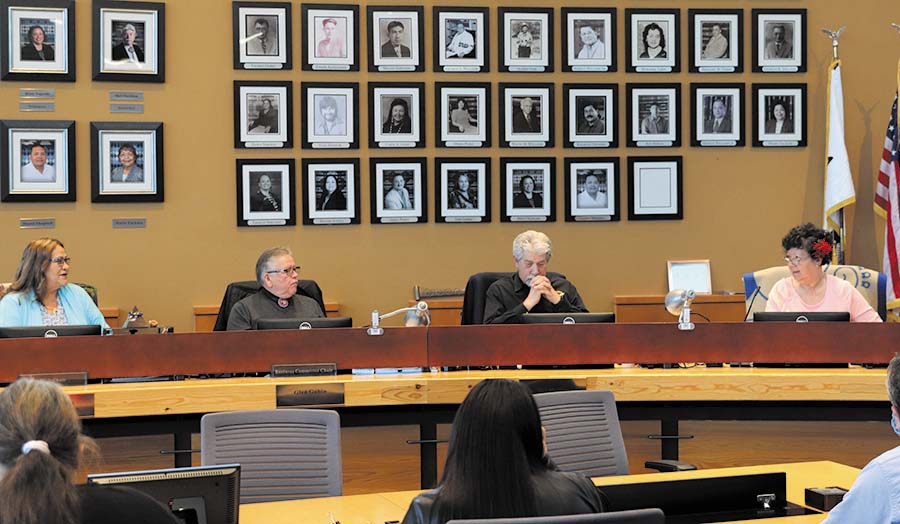
This year’s second open Board seat ended up being a battle of incumbents, with Mel Sheldon, Jr. (385) outpointing Marlin Fryberg, Jr. (375) by only 10 votes. The super slim margin once again proved that when it comes to Tulalip elections, every vote truly does matter.
“To the 1,400+ members who voted in this election, thank you, your voice speaks volumes,” reflected Mel after the election results were made official. “It shows how much our people care about their community. This was my closest election ever, outside of the year I got voted off, so it’s a real learning opportunity for me. I will make it a priority to reach out and listen to those who feel their views aren’t represented at the Board level, and look forward to building the momentum we created last year into even more economic opportunities for our people.
“As a Tribe, we are in a golden era of opportunity,” he continued. “The continued success of our casinos and other business endeavors has created so much opportunity for our people. If they choose to capitalize on it, then they have opportunity for the highest quality of education, career opportunities in construction trades, and job opportunities in a wide range of tribal programs that will help us take our economic development to the next level.”
The latest rendition of Tulalip’s Tribal Council was sworn-in on the morning of Friday, April 2 by Chairwoman Teri Gobin. Extensive well wishes and messages of appreciation were given by one Board member after another to exiting councilmember Marlin Fryberg for his two-decades of service to his people. Then Pat and Mel raised their right hands and took their oaths to preserve, serve, and protect the constitution and bylaws of the Tulalip Tribe.
“As a team, I know we can get some really good work done,” said Chairwoman Gobin as she looked towards her fellow Board members. “We have over 5,000 tribal members now. It’s our entrusted responsibility to look out for their best interest, to create and develop necessary services that keep in mind our future generations, and to work together as a team for the benefit of all of our people. It’s a challenge, but with a shared vision we can accomplish amazing things.”
The adventure of Sparky and the Easter Bunny
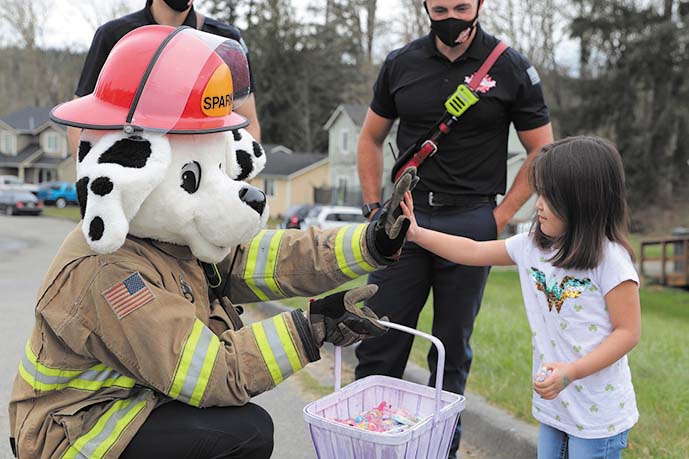
By Kalvin Valdillez, Tulalip News
Giddy with excitement and anticipation, the young children of Tulalip, some sitting in their driveways, others peeking out their blinds every five seconds, were on the lookout for two magical creatures who joined forces over the Easter holiday weekend. Both are animals but walk upright like humans and stand at approximately 6’0” in height. The characters walked through the streets of several Tulalip neighborhoods, delivering candy, bubbles and toys to the youth, who were in total awe and were über-ecstatic to see a giant bunny and a life-sized dalmatian visit them – at their home, on their very-own reservation.

The Easter Bunny and Sparky the Fire Dog responded to the call when local community-led and funded organization, Together We’re Better, needed a little assistance spreading Easter joy to Tulalip families.
“It was important for us to do an event,” expressed Together We’re Better Founder, Malory Simpson. “Normally, we do a huge Easter egg hunt and multiple communities come out to celebrate, but COVID has interfered with a lot of events this year. Seeing the kids cooped up and not having anything really planned for them, we wanted to do something for the kids and bring Easter to the community.”
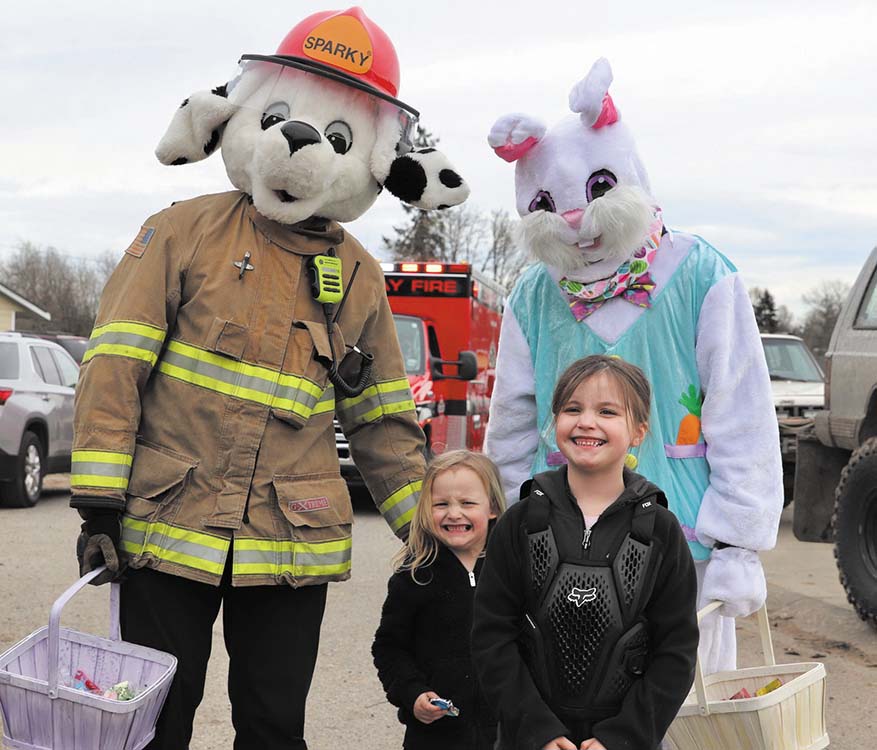
Pre-pandemic, Together We’re Better was known throughout Tulalip for their monthly potlucks and putting on exhilarating community events such as the Halloween-themed Trunk-or-Treat gathering. Together We’re Better also collaborates and assists other local organizations with their events, such as the Aunties-in-Action for their periodic food distributions.
With gathering-limitations still in place, the organization decided to bring Easter eggs to the children this year as opposed to their annual tradition of hiding them. Drawing inspiration from the Tulalip Bay Fire Department’s yearly Christmas-time Santa Run, Together We’re Better partnered with the local fire station to present a similar festivity to the community.
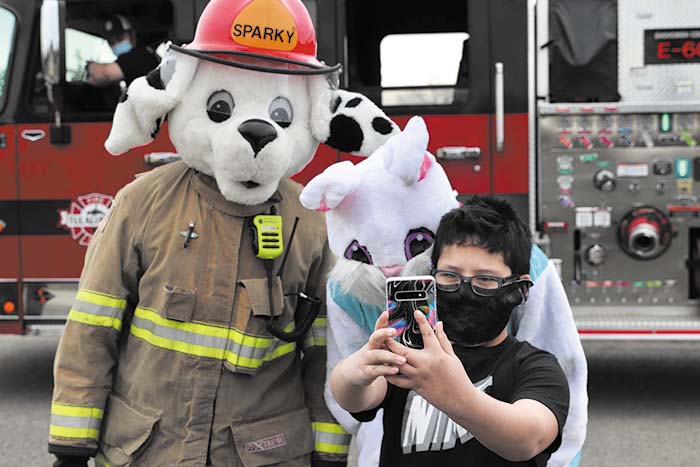
On the afternoon of April 3, Malory, a group of Together We’re Better volunteers, a number of firefighters, Sparky the Fire Dog, and the Easter Bunny gathered outside of the Tulalip Bay fire station. After the group convened for a quick game plan, the entire collective hopped to it, with baskets of candy in-hand, while escorted by a shiny fire engine and an EMS vehicle.
“Our main mission is to serve the community,” said TBFD Firefighter, John Carlson. “Serving doesn’t always mean emergency responses, it also means helping out and bringing some happiness, and today was a day exactly like that. A lot of people have been cooped up and felt kind of isolated, just kind of not in a normal state. This brought back a little bit of normalcy back to their lives. We certainly haven’t done public events like we used to in the past, so it was really great for us too. It was refreshing to get out of the station and interact with the public. I love the pure joy and smiles. Some of the kids were shaking and dancing they were so excited to see us coming.”
As the group delivered candy and other Easter goodies to the kids, they were in-turn awarded with smiles, laughter and love from the children who were happy to see the Easter bunny this year, as well as Sparky, although most Paw-Patrol fans mistook the friendly dalmatian for the show’s lead-character, Marshall. Kids weren’t the only ones to enjoy the event as many elders posted outside on their porches or driveways, greeting the procession while they made they made-their-way to the various neighborhoods within the TBFD’s district, including Mission Highlands, Silver Village, Battle Creek and the Y-Site.
Malory exclaimed, “I loved it. It felt great to be out there. A lot of these kids, I worked at their school, so it was amazing seeing them. Their smiles and laughter make you feel really good inside. Together We’re Better is community funded. We were blessed with a little bit of a donation from the Tulalip events department. At the last minute they gave us some suckers and bubbles. But for the most part, it’s community-driven and 100% community-funded. Just seeing the excitement was one of the best things about the event today, bringing some joy into the developments and seeing how happy the kids were to see the Easter Bunny and Sparky the Dalmatian.”
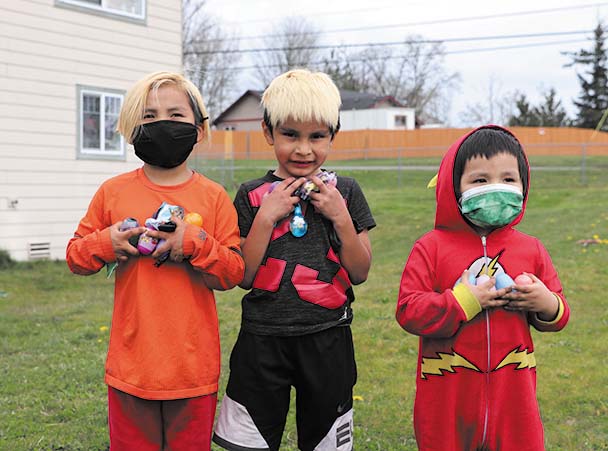
If you are looking to get more involved with the community, Together We’re Better, is always accepting donations, whether that is goods, money or your personal volunteered time. For more information, please contact Malory Simpson at (425) 905-9137.
